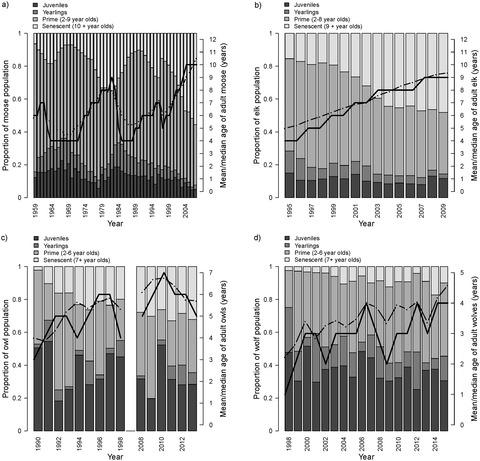当前位置:
X-MOL 学术
›
Funct. Ecol.
›
论文详情
Our official English website, www.x-mol.net, welcomes your feedback! (Note: you will need to create a separate account there.)
Fluctuations in age structure and their variable influence on population growth
Functional Ecology ( IF 5.2 ) Pub Date : 2019-08-30 , DOI: 10.1111/1365-2435.13431 Sarah R. Hoy 1 , Daniel R. MacNulty 2 , Douglas W. Smith 3 , Daniel R. Stahler 3 , Xavier Lambin 4 , Rolf O. Peterson 1 , Joel S. Ruprecht 5 , John A. Vucetich 1
Functional Ecology ( IF 5.2 ) Pub Date : 2019-08-30 , DOI: 10.1111/1365-2435.13431 Sarah R. Hoy 1 , Daniel R. MacNulty 2 , Douglas W. Smith 3 , Daniel R. Stahler 3 , Xavier Lambin 4 , Rolf O. Peterson 1 , Joel S. Ruprecht 5 , John A. Vucetich 1
Affiliation

|
Temporal fluctuations in growth rates can arise from both variation in age‐specific vital rates and temporal fluctuations in age structure (i.e. the relative abundance of individuals in each age‐class). However, empirical assessments of temporal fluctuations in age structure and their effects on population growth rate are relatively rare. Most research has focused on understanding the contribution of changing vital rates to population growth rates and these analyses routinely assume that: (a) populations have stable age distributions, (b) environmental influences on vital rates and age structure are stationary (i.e. the mean and/or variance of these processes does not change over time), and (c) dynamics are independent of density. Here we quantified fluctuations in age structure and assessed whether they were stationary for four populations of free‐ranging vertebrates: moose (observed for 48 years), elk (15 years), tawny owls (15 years) and grey wolves (17 years). We also assessed the extent that fluctuations in age structure were useful for predicting annual population growth rates using models which account for density dependence. Fluctuations in age structure were of a similar magnitude to fluctuations in abundance. For three populations (moose, elk, owls), the mean and the skew of the age distribution fluctuated without stabilizing over the observed time periods. More precisely, the sample variance (interannual variance) of age structure indices increased with the length of the study period, which suggests that fluctuations in age structure were non‐stationary for these populations – at least over the 15‐ to 48‐year periods analysed. Fluctuations in age structure were associated with population growth rate for two populations. In particular, population growth varied from positive to negative for moose and from near zero to negative for elk as the average age of adults increased over its observed range. Non‐stationarity in age structure may represent an important mechanism by which abundance becomes non‐stationary – and therefore difficult to forecast – over time‐scales of concern to wildlife managers. Overall, our results emphasize the need for vertebrate populations to be modelled using approaches that consider transient dynamics and density dependence and that do not rely on the assumption that environmental processes are stationary. A free Plain Language Summary can be found within the Supporting Information of this article.
中文翻译:

年龄结构波动及其对人口增长的可变影响
增长率的时间波动可能来自特定年龄生命率的变化和年龄结构的时间波动(即每个年龄组中个体的相对丰度)。然而,对年龄结构的时间波动及其对人口增长率影响的实证评估相对较少。大多数研究都集中在了解变化的生命率对人口增长率的贡献,这些分析通常假设:(a) 人口具有稳定的年龄分布,(b) 环境对生命率和年龄结构的影响是固定的(即平均值和/或这些过程的方差不随时间变化),并且(c)动态与密度无关。在这里,我们量化了年龄结构的波动,并评估了四种自由放养脊椎动物种群是否稳定:驼鹿(观察 48 年)、麋鹿(15 年)、黄褐色猫头鹰(15 年)和灰狼(17 年)。我们还评估了年龄结构波动对使用考虑密度依赖性的模型预测年人口增长率有用的程度。年龄结构的波动与丰度的波动幅度相似。对于三个种群(驼鹿、麋鹿、猫头鹰),年龄分布的平均值和偏差在观察到的时间段内波动而没有稳定。更准确地说,年龄结构指标的样本方差(年际方差)随着研究时间的延长而增加,这表明这些人群的年龄结构波动是非平稳的——至少在分析的 15 到 48 年期间是这样。年龄结构的波动与两个人口的人口增长率有关。特别是,随着成年人的平均年龄在其观察范围内增加,驼鹿的人口增长从正到负,麋鹿从接近零到负。年龄结构的非平稳性可能代表了一种重要的机制,通过该机制,随着野生动物管理者关注的时间尺度,丰度变得非平稳——因此难以预测。全面的,我们的结果强调需要使用考虑瞬态动力学和密度依赖性并且不依赖于环境过程静止假设的方法对脊椎动物种群进行建模。可以在本文的支持信息中找到免费的普通语言摘要。
更新日期:2019-08-30
中文翻译:

年龄结构波动及其对人口增长的可变影响
增长率的时间波动可能来自特定年龄生命率的变化和年龄结构的时间波动(即每个年龄组中个体的相对丰度)。然而,对年龄结构的时间波动及其对人口增长率影响的实证评估相对较少。大多数研究都集中在了解变化的生命率对人口增长率的贡献,这些分析通常假设:(a) 人口具有稳定的年龄分布,(b) 环境对生命率和年龄结构的影响是固定的(即平均值和/或这些过程的方差不随时间变化),并且(c)动态与密度无关。在这里,我们量化了年龄结构的波动,并评估了四种自由放养脊椎动物种群是否稳定:驼鹿(观察 48 年)、麋鹿(15 年)、黄褐色猫头鹰(15 年)和灰狼(17 年)。我们还评估了年龄结构波动对使用考虑密度依赖性的模型预测年人口增长率有用的程度。年龄结构的波动与丰度的波动幅度相似。对于三个种群(驼鹿、麋鹿、猫头鹰),年龄分布的平均值和偏差在观察到的时间段内波动而没有稳定。更准确地说,年龄结构指标的样本方差(年际方差)随着研究时间的延长而增加,这表明这些人群的年龄结构波动是非平稳的——至少在分析的 15 到 48 年期间是这样。年龄结构的波动与两个人口的人口增长率有关。特别是,随着成年人的平均年龄在其观察范围内增加,驼鹿的人口增长从正到负,麋鹿从接近零到负。年龄结构的非平稳性可能代表了一种重要的机制,通过该机制,随着野生动物管理者关注的时间尺度,丰度变得非平稳——因此难以预测。全面的,我们的结果强调需要使用考虑瞬态动力学和密度依赖性并且不依赖于环境过程静止假设的方法对脊椎动物种群进行建模。可以在本文的支持信息中找到免费的普通语言摘要。


























 京公网安备 11010802027423号
京公网安备 11010802027423号